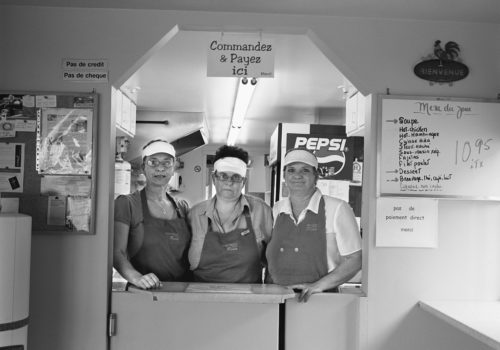Born in 1928 in Budapest, Hungary, Gabor Szilasi came to Quebec in 1958, after failing to establish himself in Sweden. His family had been decimated by the Nazis. Szilasi had worn the disgraceful yellow star. His mother never returned from the camps. He rarely speaks about it. “I usually don’t say much about all that… Many go through their reliving that pain. Not me. It doesn’t explain my photography. For the Nazis, we were enemies because of our Jewish origins. For the Soviets, after the war, we were enemies because my father owned a small shop, which made us bourgeois. I tried to flee Hungary in 1949 and ended up in prison, which is why I couldn’t continue my studies in medicine. In 1956, thanks to the revolt, we were able to offer the villagers outside of Budapest a little more money to help us cross the border.”
Gabor Szilasi is considered a major Canadian photographer. Several museums have held retrospectives devoted to him, and his works are part of several permanent collections. The quality of his photographs of rural Quebec and Montreal architecture has been recognized by two of the most important Canadian visual arts prizes, the Prix Paul-Émile-Borduas and the Governor General’s Award.
Still very active, Szilasi has worked all summer in Gaspé, exhibiting recent portraits. “I photograph the moment in the present, but as soon as the shutter clicks, we are suddenly in the past. With the exception of my recent photos from Budapest, where I photographed out of nostalgia, my work doesn’t romanticize the past. I like to discover a balance between specificity of the moment and the way that it’s seen. The rest only comes after, in spite of myself.”
His work, mostly in black and white, takes human nature as its subject. “I first photographed what interested me. Sometimes, it was geometry or light itself, then architecture, cities, the presence of men. It was after thirty years of taking pictures that I finally focused on man, when I became increasingly aware of specific themes in my work. At first I wasn’t sure what I was doing. There was, I would say, a certain naivete in my photographs. I was trying to frame them like a painter but always ended up with something else. When I shot the motorcyclists at Lake Balaton, for example, I didn’t immediately see that it was a good photo. It broke the traditional rules. I only developed it much later… When my students were reframing their photographs, I encouraged them to consider how they first perceived it. First impressions are precious.”
In Budapest in 1952, the young Szilasi bought a Zorki, a Russian copy of the famous Leica camera. Why the interest in photography? Fate had yet to lead him to the work of the Hungarian masters, like André Kertész. (One of the latter’s most famous photographs hangs in Szilasi’s living room.) It was a uncontrollable urge to satisfy his need to express the way he saw the world. And that expression took the form of an image.
“I wanted to draw and paint. I still think about it sometimes,” explains Szilasi. “But painting doesn’t match my temperament. I eat quickly, like a Hungarian! I’ve always been impatient. Once I’ve taken thirty photographs on a theme, I stop and go look elsewhere. Other people spend their lives digging in the same furrow. […] First I took pictures with the Leica, then in a medium format, then large format, Polaroids, panoramics, all sorts of things.”
His passion for rural Quebec, he says, stems from his unfamiliarity with the Hungarian countryside of his youth. “I spent very little time outside of Budapest. I missed out on the rural experience. In Quebec I was looking for the traces of man in the countryside, the life there. But I never photographed the pure countryside, like Ansel Adams. That doesn’t interest me. Because I was working for the National Film Board of Quebec, I was given the opportunity to discover different human worlds. I could feel the differences between Beauce, Charlevoix, the Ile-aux-Coudres and other regions, and I wanted to understand them better. I found them interesting. I photographed the people from these regions, both well known people and ordinary people.” It was in this context that he has become so attached to Gaspé in recent years.
Szilasi likes the simplicity of people who have a real presence but who aren’t stars of any kind. “I’ve always avoided photographing famous people. In those cases, you’re really photographing reputations. You can’t take a bad picture of Mick Jagger or Marilyn Monroe… The daily lives of ordinary people always seemed more interesting to me.” His passion for the city carries the same interest in humanity. “The transformation of the world, at the heart of everyday life, fascinates me as much as ever.”
Jean-François Nadeau
















